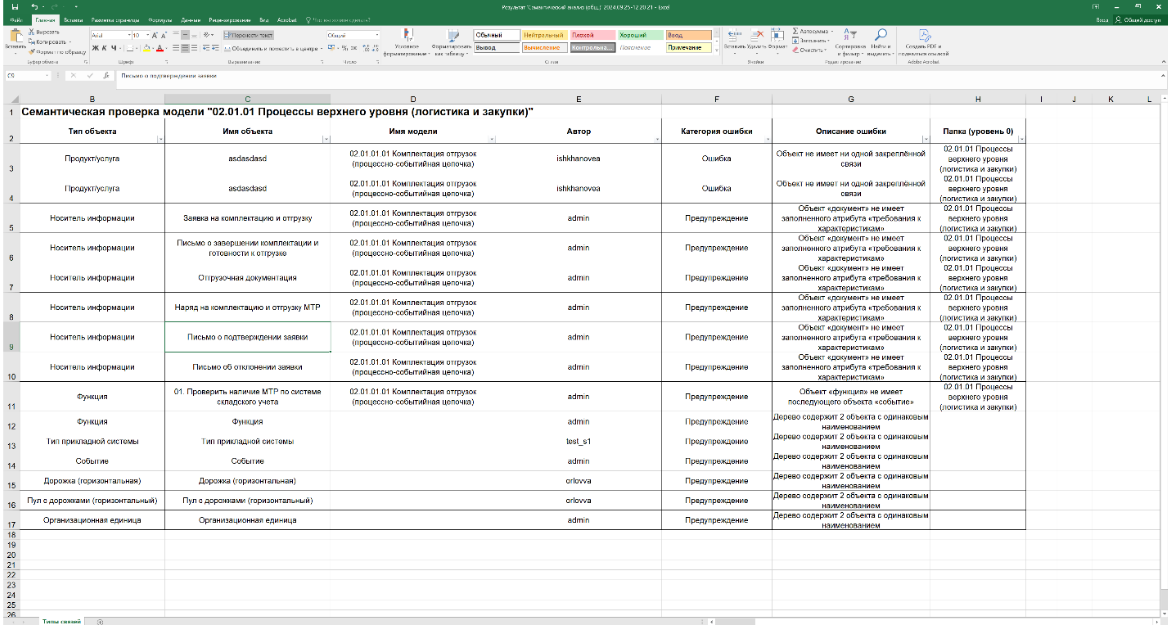
Semantic Model Validation in SILA Union Software
Semantic model validation plays a crucial role in ensuring the efficiency, consistency, and reliability of business processes, IT infrastructure, and strategic management within an organization. It helps confirm that all elements of the system are logically coherent and align with both the intentions of developers and the business requirements.
In this article, we will explore why semantic validation is necessary and examine its implementation in SILA Union software.
Ensuring Consistency Across Architectural Layers
Corporate architecture typically consists of multiple layers (or domains), such as:
Business Architecture
Application Architecture
Information Architecture
Technical Architecture
Semantic validation ensures that all these layers are correctly interconnected. For example:
Business processes must be accurately reflected in applications and systems.
Data used at the information architecture level must align with business requirements.
Technical solutions must support the functionality described in the application architecture.
Without semantic validation, gaps between these layers may arise, leading to misalignment between strategic company goals and their actual implementation.
Detecting Conflicts and Redundancies
In large organizations, different departments or project teams often create models that may conflict with each other or duplicate existing solutions. Semantic validation helps detect such issues at an early stage, preventing:
Conflicts between business processes or systems.
Unnecessary duplication of functionality.
Inefficient resource allocation.
Example: If two departments develop separate customer management systems but use different data formats or methodologies, integration challenges and data loss may occur.
Ensuring Compliance with Standards and Regulations
Many organizations must adhere to strict regulatory requirements (e.g., GDPR, SOX, HIPAA). Semantic validation ensures that corporate architecture models comply with these standards, which is particularly important for:
Protecting personal data.
Ensuring information security.
Example: A data processing model must explicitly define the procedure for obtaining user consent to store personal data to meet GDPR requirements.
By integrating semantic validation into SILA Union, businesses can streamline architecture consistency, prevent inefficiencies, and maintain regulatory compliance, ensuring a robust and adaptable enterprise structure.
Detecting Blind Spots and Gaps
When designing corporate architecture, it is easy to overlook critical details, especially in complex models with many interrelated components. Semantic validation helps identify blind spots and gaps, such as:
Missing descriptions of key business processes.
Insufficient integration between systems.
Unaccounted dependencies between components.
By addressing these issues, organizations can improve model accuracy and completeness, reducing the risk of implementation errors.
Optimizing Decision-Making
Corporate architecture supports strategic decision-making, including technology selection, process reengineering, or company mergers. Semantic validation ensures that models provide accurate and reliable information for decision-making, helping to:
Assess the impact of changes on business processes and IT systems.
Select the most effective solutions based on model analysis.
Anticipate potential risks and challenges.
Example: Before implementing a new ERP system, semantic validation can confirm that the model meets business needs and prevents unforeseen consequences.
Managing Change
In modern organizations, processes and technologies are constantly evolving. Semantic validation helps monitor these changes, ensuring that new model versions remain accurate and consistent. It allows companies to:
Check how changes in one component impact other system elements.
Identify possible side effects.
Ensure backward compatibility.
Example: When introducing a new order management system, validation ensures it does not disrupt existing payment and delivery processes.
Enhancing Communication Quality
Corporate architecture serves as a shared framework for different stakeholders, including executives, IT specialists, business analysts, and external partners. Semantic validation ensures that models are clear and unambiguous, improving communication and collaboration.
Example: A business process model should be equally understandable to both top management and software developers.
Supporting Automation and Digital Transformation
As organizations adopt automation, AI, and cloud technologies, semantic validation ensures that the existing architecture is ready for transformation by:
Confirming that the current system structure supports automation.
Identifying areas where automation will have the most impact.
Preventing errors in technology integration.
Example: Before deploying a machine learning system, validation ensures that training data is accurately described and available in the correct format.
By integrating semantic validation into SILA Union, businesses can enhance their corporate architecture, decision-making, and digital transformation efforts, ensuring a robust, future-ready infrastructure.
How Semantic Validation Works in SILA Union
The SILA Union software enables semantic validation through a dedicated script. This script analyzes text data for accuracy, completeness, and compliance with corporate standards. The process includes:
Checking conformity with internal corporate standards.
Identifying errors or inconsistencies.
Detecting ambiguities in model descriptions.
The script processes the textual data within the model and generates a report highlighting detected issues or deviations.
Execution Process
The script is launched directly on the model (Figures 1, 2, 3).
Figure 1: Object for script execution ("Semantic Validation" tool).
Figure 2: Script selection window.
Figure 3: Validation results and error report.
Report Generation
After executing the script, an Excel report is generated, displaying any errors or inconsistencies identified in the model. This report helps the responsible modeler quickly detect and resolve issues.



Conclusion
The semantic validation capabilities in SILA Union serve as a critical tool for ensuring consistency, correctness, and efficiency in organizational management systems. By identifying errors, contradictions, and gaps early, businesses can significantly reduce risks and costs associated with later implementation stages. Additionally, semantic validation enhances architecture clarity for all stakeholders and facilitates smooth adaptation to changes in a rapidly evolving business landscape.





